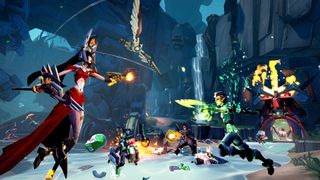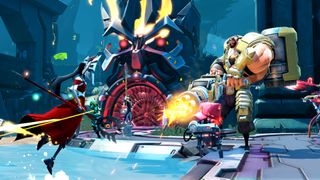Battleborn, the FPS that wants to be everything to everyone

Fewer and fewer FPSes are taking the ‘complete package’ approach.
When they announced it at E3 2014, Ubisoft said that Rainbow Six Siege would have a campaign, but later corrected themselves that it wouldn’t. Fans reacted strongly when EA ruled out the possibility of single-player in Star Wars Battlefront. And other, similar upcoming games—Overwatch, Paladins, Gigantic, Battlecry—will be strictly multiplayer only.
In this fundamental way, Battleborn is distinguishing itself from its ever-growing list of competitors. You can play Battleborn as a solo campaign, or you can play that campaign cooperatively. Or you can wade into Battleborn’s multiple 5-on-5 competitive modes, one of which features towers and minions, but is a long way from being a MOBA—way less than something like Smite, for example.
But after playing Battleborn in most of the different ways you can play Battleborn, I worry about the possibility that this will be a game that, instead of forming a strong identity around one idea, will bundle together two or three middle-of-the-road experiences.
That isn’t to say that Battleborn isn’t polished. Its first-person animations are as nuanced and pleasant over time as anything from the past few years, and embrace the spectrum of sci-fi, military, and fantasy personalities Gearbox has plugged into the game. Mecha-suited Caldarius’ laser SMG splits open to vent heat when you have to reload. Fire mage Ambra’s staff doesn’t swing blandly, but lunges out at enemies like a piston, alternating from the right to the left side of the screen as she completes a combo. I didn’t expect to enjoy a melee character so much, but I loved playing samurai with Rath’s suite of slashing and sword-tossing abilities.
But in this age of ‘lifestyle’ games, where more and more players are dedicating most of their time to a single, high-skill-ceiling competitive game, I’m not convinced that Battleborn will be what I invest myself in next year. I played a few rounds of Capture on Outback, a rocky canyon map dotted by A, B, and C capture points. It’s a standard setup: accumulate score when your team owns the majority of capture points. The mode works fine in the context of Battleborn’s variety of AOE, pop-up, ranged, and melee abilities. But the layout of the map itself, Outback, put me to sleep. Outback’s simple architecture made positioning almost arbitrary, and didn’t prompt strategic decisions. My team and I simply scurried between the uncaptured points at intervals, and the routes between them were so generously wide that you’d think it was a level designed for 20 players, not 10.
Money problems
Both competitive maps I played, though, highlighted one of the stranger aspects of Battleborn, which is how isolated currency is as a mechanic in competitive multiplayer. There are no items or character equipment options in Battleborn—MOBA-style, your character levels up over time within a match. But there is a currency that you scrounge for in order to buy turrets or activate loadout items, personal buffs that you equip pre-match. What I didn’t like was how segregated shards were on the map and how unimportant they were to winning a match. Shards are presented in the same way they are in the campaign, as pickups that simply sit in the environment, waiting for you to smash like a crate. Their placement is weird, in neglected corners of the map where I rarely intersected with enemies, and as a result gathering shards felt like a detour away from combat with no challenge or strategic thinking associated with it. I was also surprised how little impact turrets had—they were easy to dismantle and their placement, again, felt slightly away from the capture points and high-traffic areas.
The biggest gaming news, reviews and hardware deals
Keep up to date with the most important stories and the best deals, as picked by the PC Gamer team.

Meltdown mode made a better impression despite suffering from a few of the same flaws. In Meltdown you escort waves of your team’s robot minions into the enemy’s endzones—garbage-compacting maws that destroy your minions but, as they eat them, score points toward victory. On the map Paradise, minions spawned in two parallel lanes, which at least gave an incentive for my team to group up, set ambushes, and scout a little, unlike Capture. Still, the maps felt too spacious—all 10 players could fight comfortably in a segment of one lane, and the shards sat in isolated areas of the environment away from the objectives.
Although I’m less fond of what I’ve seen of Battleborn’s structure, I am happier with the feel of most of its fighting. There’s a simplicity across the experience comparable to Overwatch (for example: you reload, but there’s infinite ammo on all weapons), but there’s depth, too. As Orendi the four-armed mage, I figured out that I could use one of her abilities, Nullify, offensively rather than defensively. Nullify is built as an escape ability: it throws Orendi backwards and leaves a trail of harmful magic on the ground, daring enemies to chase. But by turning my back to enemies, estimating my aim, and hitting Nullify, I turned it into a harassment tactic. Nullify dealt some initial damage, pushed me through a pack, and baited enemies to chase me through the pools of damage I’d put between us.
I’m confident that these sorts of creative plays will be possible for other characters, like Benedict, a cyborg birdman who can glide across the map. Battleborn is out in February, but there's still more to see, including one multiplayer mode. “My favorite characters to play right now are the back 10, the ones we haven’t revealed,” Battleborn creative director Randy Varnell told me. “We have a character that, in a very Zer0-like [Borderlands 2’s ninja] fashion, creates a duplicate of itself. And Halo: Reach did that, with its hologram thing, but this character, when the bot goes out you turn invisible and the bot AI takes over and fights, and looks very much like that character,” says Varnell.
"We have a character that, in a very Zer0-like fashion, creates a duplicate of itself."
“The dummy-decoy is something you’ve seen before, but this does it in such a strong, deceptive way… I’ve played a lot of those decoy-type players in other games, but I’ve never felt as giddily excited as when I dummy-decoy with this character and I’m behind someone, and I know they have no idea that I’m there.” Varnell’s honest enthusiasm is encouraging. “We have a self-learning kind of bot algorithm that will look at progress across the course of competitive matches, look at how that character is usually played—where it goes, what decision does it make—and can learn from that based on what the community’s doing.”
Part of me feels like I'm advocating for 'less game' in saying this, but I’m conflicted about whether Gearbox and 2K’s decision to bundle a bespoke campaign with competitive play will translate to a better experience. I’ve enjoyed enough of my time playing Battleborn, but I remain lukewarm on it because I haven't walked away from my hands-on time with a clear sense of Battleborn’s identity. Overwatch builds on TF2's ideas with aggressively varied abilities. Rainbow Six Siege is about high-fidelity tactical destruction. Even Battlecry, for the many flaws it’s demonstrated so far, is coherent as a third-person melee game with speedy movement.
I'm still waiting to figure out, let alone be able to express in a simple sentence, what Battleborn's big contribution will be to PC gaming when it releases next year. Then again, maybe its 'more is more' approach will help it find a stronger community than 2K’s last FPS, Evolve, which went all-in on its '4v1' asymmetrical format.

Evan's a hardcore FPS enthusiast who joined PC Gamer in 2008. After an era spent publishing reviews, news, and cover features, he now oversees editorial operations for PC Gamer worldwide, including setting policy, training, and editing stories written by the wider team. His most-played FPSes are CS:GO, Team Fortress 2, Team Fortress Classic, Rainbow Six Siege, and Arma 2. His first multiplayer FPS was Quake 2, played on serial LAN in his uncle's basement, the ideal conditions for instilling a lifelong fondness for fragging. Evan also leads production of the PC Gaming Show, the annual E3 showcase event dedicated to PC gaming.
Most Popular

